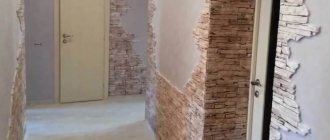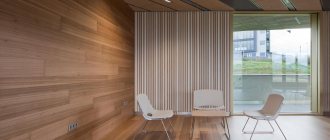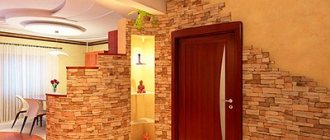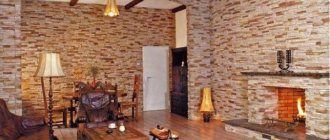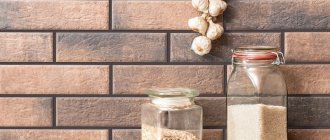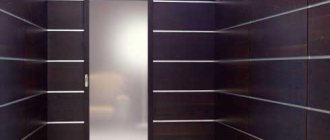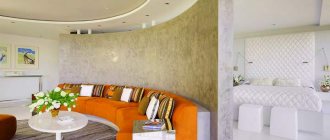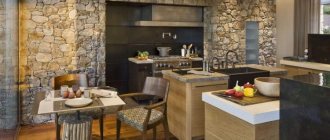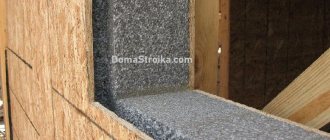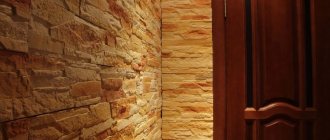Oriented strand boards have firmly occupied their niche in the finishing segment. Last but not least, this is influenced by the price-quality ratio. The cost of the material is really low, since wood chips and shavings are used as raw materials. The closest “relatives” of oriented strand board - plywood and chipboard - lose by this criterion. Therefore, decorating a room with such material is more than beneficial.
After finishing the room with pox slabs, you can cover their surface with stain or varnish. Or use many other finishing options; we’ll talk about this and more below.
Production technology
OSB sheets resemble plywood and chipboard at the same time. As a rule, the raw materials for production are pine, poplar, and maple. At the factory, logs can be barked, sawed into blanks, and then split into strip chips. That is, the raw materials are similar to those from which chipboard is produced.
After drying and sorting the chips, the material is mixed with various binders (for example, paraffin, resin). Next, a chip carpet is formed. The chips are laid in layers, which resembles plywood. After pressing, the same slab is obtained, which is cut, packaged and sent for sale.
Size range of slabs
The strength of the OSB board is important to the consumer. Restrictions on the use of products in loaded structures depend on this characteristic. For the construction of walls, OSB 9 mm thick is traditionally used.
If required, you can buy sheets up to 26 mm. The length and width of the products do not change: standard size slabs are available on the Russian market: 2500 by 1250 mm.
Materials coming from North America have different dimensions. Here, the typical dimensions of the OSB panel are slightly different and are 2440 by 1220 mm. However, products from North American manufacturers rarely reach Russia.
Benefits of OSB
All the strengths of OSB can be divided into two parts:
- advantages over plywood and chipboard;
- before other materials.
Let's start with the first ones:
- price. Of course, wood is cheaper than other finishing materials. Compared to its counterparts, chipboard is cheaper. But, alas, the quality in this case corresponds to the price;
- strength. Thanks to their multilayer structure, the slabs boast high strength characteristics. True, plywood has approximately the same indicators. But chipboard cannot boast of strength;
- resistance to moisture. OSB performs well in conditions of high humidity. The same can be said about plywood. But chipboard is destroyed under its influence;
- environmental friendliness. The material contains synthetic resins, but in small quantities. An important point: the products are labeled indicating the level of environmental friendliness; You need to pay attention to this when purchasing. By the way, according to this indicator, OSB is considered safer than chipboard and plywood.
Based on the above, we can conclude that oriented strand boards are better than their closest analogues. Now let's move on to the second group of advantages:
- light weight. The slabs weigh from 15 to 40 kilograms, which makes them easier to install on walls;
- ease of processing. OSB lends itself very well to sanding, cutting, painting and other actions;
- no need to buy special tools for installation;
- large selection of sizes. So, you can choose fairly large slabs to reduce the number of joints to a minimum.
Is it possible to sheathe a bathhouse and a garage inside with an OSB slab?
Garages and other outbuildings do not belong to the category of residential premises, therefore the requirements for the quality and environmental friendliness of building materials are lower. Finishing the interior walls of the garage with OSB slabs is allowed without further finishing. The requirements for the bathhouse are higher. The influence of high temperatures and humidity contributes to the destruction of OSB. As a result of temperature exposure, harmful compounds are released, so finishing the inside of bathhouses with OSB sheets is impractical. You can use them only as an element of rigidity of the frame, sheathing the building along the racks from the outside, and for interior decoration you should choose lining or imitation timber.
Types (according to criteria)
Environmental friendliness
Many people have probably heard about the harmfulness of finishing premises with oriented strand boards. The fact is that the production of stoves uses formaldehyde, a gas considered harmful to health. True, if used in small quantities, this element will not cause harm.
There are two classes of this gas content in the finishing material: E1 and E2. In terms of labeling, they are the same both in Russia and in Europe, but in terms of numbers they differ:
- euro: E1 - no more than 8 mg/100 g; E2 - 8-15 mg/100 g;
- Russian: E1 - up to 10 mg/100 g; E2 - 10-30 mg/100 g.
European companies produce slabs only with class E1. In addition, large manufacturers try to use formaldehyde in a ratio of 6.5 mg/100 g. Unscrupulous competitors often use a larger percentage of synthetic resins, which contain formaldehyde, to reduce the cost of products. Therefore, it is better to focus on large and trusted manufacturers.
Moisture resistance and strength
These two indicators divided the slabs into 4 classes:
- OSB-1. The cheapest option, but at the same time the least durable and moisture resistant. It is not worth buying such slabs for finishing work. But they are well suited for furniture and packaging containers;
- OSB-2. This material has great strength, but is still afraid of moisture. The price for it, as in the first case, is more than affordable. These slabs are used for various structures (for example, beams), but only in rooms with low humidity levels;
- OSB-3. This analogue is the most popular because it is characterized by sufficient moisture resistance and strength. These OSB boards are most suitable for interior decoration. True, this is also reflected in the price, but it is still considered affordable;
- OSB-4. Such boards are resistant to moisture and are also extremely durable. Since their price is the highest, you should think carefully about whether such high strength is needed for finishing.
Dimensions
Those who have previously encountered chipboard and are accustomed to their standard size may be surprised to notice the variety of OSB dimensions. One of the reasons for this phenomenon is the history of production of the material. The fact is that oriented strand boards began to be made in North America, and only then they gained popularity in Europe. And it so happened that different sizes gained popularity on each continent. The most popular of them are:
- 2440x1220 mm. (these numbers are popular in America);
- 2500x1250 mm. (such slabs can be called a European analogue of the previous version);
- 2440x590 mm. (this is also an American type of material that has tongue and groove edges; OSB of this size is best suited for laying floors).
The thickness of the slabs also varies - from 6 to 40 mm. The thinnest ones are used for constructing subfloors that will not be subject to heavy loads. As for wall coverings, the choice here depends on the specific situation. As a rule, slabs with a thickness of 10-12 mm are used.
Some rules for greater safety
The first time (about six to seven months) after installation, the most intense release of harmful fumes occurs. If you regularly ventilate the room, the negative impact on the body will soon begin to subside. But for greater safety, additional processing of the slabs is carried out.
If the work takes place in a children's room, then compositions with detoxifying properties are chosen as a primer. For common areas, simple water-dispersed paints, varnishes, wax, and penetrating primer are suitable.
Particular attention is paid to the ends. It is through them that the main amount of harmful substances is released. It is enough to saturate them with varnish or primer.
Priming is one of the safety measures that allows you to reduce the amount of harmful substances released
On a note! Simple surface covering is the best guarantee of protection against the release of harmful substances.
It should be taken into account that the rate of release of toxic elements is affected by temperature. The higher the indicator, the more formaldehyde in the air. The norm is considered to be 30 °C.
In general, there are two main ways that allow, without making excessive efforts, to rid the room of chemical components and saturate it with oxygen. Namely, frequent ventilation and the presence of indoor flowers.
OSB is not recommended for use in rooms where temperatures exceed 30 °C
Any modern building or finishing material that is made using chemical components can emit harmful substances. But manufacturers are constantly trying to keep these figures to a minimum.
Slab finishing options
Using varnish and stain
OSB itself looks attractive; therefore, there is no special need for finishing it. To highlight the natural beauty of the material, you can use varnish. To do this, you either need to purchase sanded slabs or sand them yourself. Then the surface is cleaned and degreased, after which several layers of varnish are applied to it.
Another good way is to use stain, which can also highlight the structure of the slabs. The composition is diluted with solvent or water. It is best to use acetone, which, when it evaporates, helps the coating dry quickly. But you need to work with it carefully. So, the room should be well ventilated, and you should work in a respirator. For application you can use a brush, roller or spray. After applying each layer, you need to let it dry and only then proceed to the next one.
For those who like the aging effect, you can use patina. To do this, apply primer to the stain layer and only then apply patina, which, after drying, is wiped off with a sponge. All that remains is to apply varnish to fix it.
Coloring
This technology is similar to the previous one: you need to remove dust and degrease the surface, recess the screw heads, and seal the joints. The only difference is that the slabs must first be primed and only then proceed to the main stage.
Separately, it is worth mentioning the choice of paint. Firstly, it must be intended for interior work. Secondly, you need to select an option suitable for the type of wood from which the slabs are made. Thirdly, it is better to give preference to acrylic paint, which suits best. But water-based ones can lead to swelling of the panel. It is worth painting all sides, including the ends, to avoid swelling of the fibers.
Wallpapering
This type of finishing is more complex than the previous ones. So, the surface must be primed and puttied. This creates a layer that provides protection and increases adhesion. It would not be superfluous to use reinforcing mesh. If it is provided, you need to remember the basic rules:
- installation of reinforcing mesh begins with slopes;
- the joints should not coincide with the corner.
The actual wallpapering on the slabs does not differ from the usual one. As with other types of walls, any type of material can be used. You also need to choose a good glue; for greater adhesion, you can add PVA to it.
Video description
The video shows how you can glue ceramic tiles to OSB:
It should be noted that glue in cans is not a cheap pleasure. Therefore there is another option:
- a plaster synthetic mesh is attached to the wall covered with OSB boards ;
- putty is applied on top ;
- After drying, tiling .
Wallpapering
What is not recommended to do is stick wallpaper on OSB. This means directly on the surface. As with paint, the slabs must be primed. And pre-sand. The primer must be applied in two layers, the first must dry thoroughly before covering the second.
After which it is recommended to apply two layers of interior paint. But after it dries, you can glue wallpaper.
Formaldehyde and other hazardous substances
In fact, it is quite possible to make OSB boards from natural resins that are diluted with minor additives. But this technology is quite expensive and does not allow the production of the required volumes of material. Therefore, the adhesive mass is replaced with a mixture of formaldehyde, phenol and other toxic substances.
Their presence in the air leads to the following problems:
- The appearance of allergic reactions and frequent headaches.
- The occurrence of skin diseases.
- Difficulty breathing and constant watery eyes.
- General decrease in immunity.
High levels of formaldehyde and other hazardous substances in the air can lead to negative health effects.
A certain threshold for formaldehyde levels has been established. It is no more than 0.5 mg per m3.
Methods for finishing OSB inside the house
Painting OSB inside the house
A house sheathed with OSB often needs finishing. The texture of the material is very characteristic and is not compatible with all styles. You can finish the slabs in a variety of ways:
- Painting is the easiest method to change the color and even texture if you take enamel with high hiding power. Use any paints for interior decoration. However, before work, the material is primed, sometimes twice: the porosity of the slab is high enough to literally “absorb” a layer of paint.
- Wallpaper - it is better to take unpolished slabs for this finish. Sanded surfaces have a very smooth surface; heavy non-woven wallpaper will not stick to it. Any materials can be glued, since OSB has very low vapor permeability.
- Ceramic tiles - the flat surface of the cladding allows you to lay tiles of any size and shape. The material is strong enough to mount not only ceramics, but also porcelain stoneware panels.
- Decorative putty - before finishing the slabs also need to be primed to increase adhesion. Compositions with coloring pigments, colored chips, and pieces of silk are applied in a thin layer and leveled.
Other methods are also allowed: finishing with plastic panels, cladding, applying liquid wallpaper. You can even cover the walls with fabric wallpaper.
Danger of use in residential construction
The production technology of OSB boards involves the addition of binders with a pronounced odor. It does not erode for a long time. When covering walls, installing floors or ceilings, you should take into account that the smell will remain in the room for several weeks.
If you purchased material from a trusted manufacturer, it will disappear faster. If slabs of dubious quality were purchased, the smell may remain in the house for several months.
The problem described above may arise due to the selection of the wrong category of OSB panels. Products intended for outdoor use contain resins with a different chemical composition compared to boards used for work inside residential spaces.
The danger comes from formaldehyde fumes. All sheet building materials resulting from wood processing have this disadvantage. OSB panels contain less formaldehyde than particle boards.
When choosing products for indoor use, you must ask the seller for a certificate of conformity - it confirms the safety of the products. Certified products contain small amounts of formaldehyde and other resins that are toxic to humans.
Furniture made from OSB.
